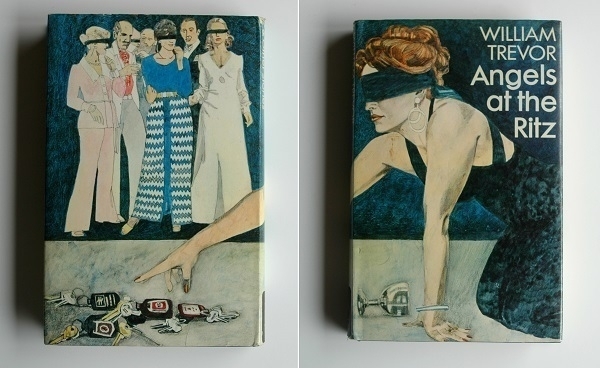Angels at the Ritz

Having more-or-less exhausted the bodies of work of some of my favourite short-story writers, I thought I’d try someone new, and ordered a collection by the renowned Irish author William Trevor: Angels at the Ritz (and Other Stories). The book’s striking front cover depicts a bindfolded woman on her hands and knees. The design wraps around to the back cover which provides the context: a ‘key party’ is at its crucial stage with the woman about to select a key and with it a partner for the rest of the night.
The image relates to the volume’s title story. In it, thirtysomething Londoners Gavin and Polly attend a party thrown by old friends where partner-swapping is on the agenda, although they intend to leave before things get to that late stage. During the party both are (separately) propositioned, with Polly recoiling from the suggestion but Gavin demurring only with a reluctance observed by his wife, who realises it marks a turning-point in their marriage. The somewhat sordid goings-on are portrayed as a fall from grace when contrasted with the friends' recollections of an impromptu gathering years beforehand (well beyond their usual means) at the Ritz Hotel. Rather more shocking to the modern reader than the swinging shenanigans is the fact of Gavin, described as having put away at least four G&Ts, drunk-driving them back from the party, and then giving their babysitter a lift home afterwards: something which doesn’t cause Trevor to so much as lift an authorial eyebrow in disapproval.
I admired the book more than I enjoyed it. I felt there was something of Chekhov in Trevor’s outlook – which would be higher praise coming from someone who better appreciated the Russian’s writing. It’s a book of solid endings: Trevor makes sure to clearly put across a point or a moral or an insight at the end of each tale. I prefer a little more subtlety myself, while conceding that an excess of inconclusive ambiguity can be more annoying than heavy-handed closure. What I did love about the writing were the powerfully vivid evocations of time & place throughout. My favourites of the stories were placed one after another near the middle of the book: ‘The Tennis Court’, ‘A Complicated Nature’ and ‘Teresa’s Wedding’.